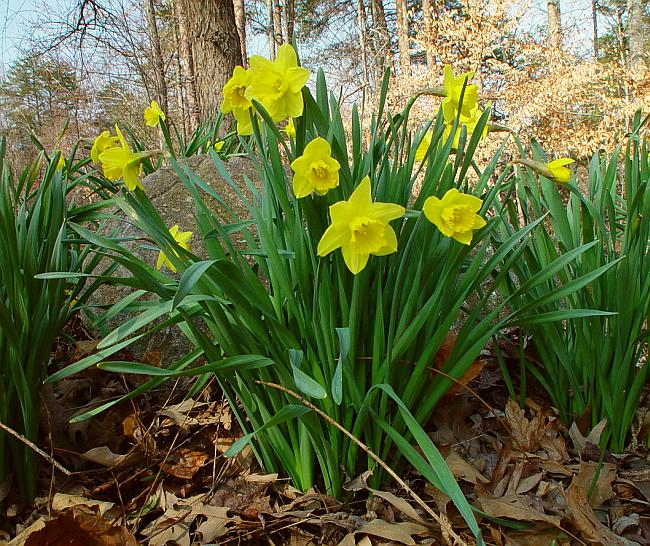Narcissus pseudonarcissus L.
Daffodil

Introduced
CC = *
CW = 5
MOC = 9
© DETenaglia
Narcissus pseudonarcissus L.Daffodil | |
 |
Introduced CC = * CW = 5 MOC = 9 |
© DETenaglia |
|
Family - Liliaceae Habit - Perennial forb, with bulbs. Stems - Erect, to 50 cm, unbranched, somewhat flattened, glabrous, with several bladeless sheaths in addition to the foliage leaves. Leaves - Basal, several, 20-50 cm long, linear, flat, glabrous, often glaucous.
Inflorescence - Usually solitary flower at stem tip, subtended by a papery spathelike bract. Flowers - Nodding to spreading, with stalks 10-45 mm long. Perianth 35-80 mm long, yellow, fused into a narrow, cylindrical or funnelform tube in the lower half, the lobes oblanceolate to obovate or broadly elliptic, spreading. Tubular corona of petaloid tissue present inside the perianth lobes at the top of the perianth tube. Corona about as long as or slightly longer than the perianth lobes, the tip usually crinkled, yellow. Stamens 6, situated inside the corona and fused to the perianth tube. Style 1, the stigma shallowly to deeply 3-lobed. Ovary inferior, with 3 locules, each with numerous ovules.
Fruits - Ellipsoid capsules, rarely produced in North American plants.
Flowering - February - April. Habitat - Cultivated, also escaped to roadsides, old homesites, disturbed areas. Origin - Native to Europe. Lookalikes - Narcissus poeticus. Other info. - This is the globally known and loved daffodil, one of the most easily recognized flowers and one of the first to bloom in the spring. It is cultivated across Missouri as well as countless other places across the country and the globe. The flower differs from other members of the lily family by having a projecting corona which gives the flower its distinctive look. Different cultivars and polyploids of the species will have coronas and petals of different colors. Some cultivars have the stamens replaced with petals and these double-flowered types are sometimes called "Scrambled Eggs." The extensive history of cultivation obscures native ranges and morphologies. The lookalike species N. poeticus L. has white petals and a much smaller corona.
Photographs taken in Brown Summit, NC., 3-13-03 (DETenaglia); also at Weldon Spring Conservation Area, St. Charles County, MO, 4-5-2008, near Labadie, Franklin County, MO, 3-26-2019, Shaw Nature Reserve, Franklin County, MO, 2-22-2020 and 4-30-2021, and St. Joe State Park, St. Francois County, MO, 3-26-2020 (SRTurner). |